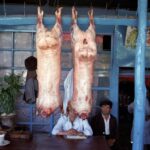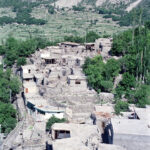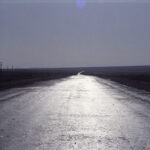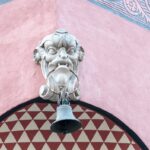Turpan
Turpan has long been the centre of a fertile oasis (with water provided by the karez canal system) and an important trade centre. It was historically located along the Silk Road. At that time, other kingdoms of the region included Korla and Yanqi.
The Turpan Depression or Turfan Depression, is a fault-bounded trough located around and south of the city-oasis of Turpan, in the Xinjiang Autonomous Region in far Western China, about 150 kilometres (93 mi) southeast of the regional capital Ürümqi. It includes Lake Ayding, −154 metres (−505 ft), the second or third lowest depression on Earth. By some measures, it is also the hottest and driest area in China during the summer.
Breakfast was served outside in the hotel’s garden. Overhead, a carpet of vines cooled the air and softened the glare into pools of dappled sunlight. The temperature had already climbed to 40oC. After so many hours spent driving through deserts, the prospect of a drive into the Turpan Pendi, a desert of roasting rock and sand that covered the Depression, was surprisingly appealing.
The morning was spent wandering around the bazaar. The heat sapped my energy, so I returned to the hotel to test the local melon juice and a bottle of chilled beer.
The minibus arrived promptly at five o’clock Beijing time with the temperature already at 45oC and the sun high in a cloudless sky. The road into the Turpan Pendi was very straight and metalled. The road surface glistened as though there had been recent rain. In fact, it was already little more than a river of molten tar.
Two hours later, the bus rattled to a halt at the Bizaklik Thousand Buddha Caves in the Moutou valley. This vast complex of Buddhist caves had been a prosperous centre of religious activity up to the 13th century, when it too had been abandoned. In most of the caves, there was ample evidence of the damage inflicted by vandals and Muslim fanatics on these caves over the centuries. Hundreds of the paintings had been desecrated with faces scratched off or daubed in mud because of the Muslim belief that the human countenance should never be represented in art. On one wall was graffiti stating that Voi le Coq had come here and removed whole paintings to Berlin, where they were safe from the Muslims, but not from the bombs dropped by the allied Air Forces during World War II.
Beyond the caves were the ruins of the city of Gaochang, a great centre of trade that was established a thousand years before Jesus Christ and abandoned in the sixteenth century as the economic importance of the Silk Road waned. Although the risks to the merchants that plied their trade along the Silk Road were great, they accepted those risks because the rewards were high. They faced raiders, inhospitable deserts, disease, endless sandstorms, lack of feed for their animals and high passes, but the profits to be gained kept the Silk Road alive.






Leave a comment